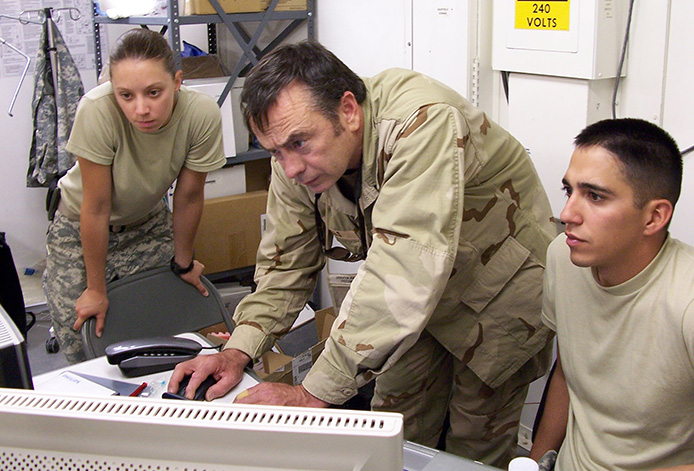USAMMA Team Keeps Complex Medical Equipment Working in Complex Environment

Somewhere in the world right now, there is a small, highly-skilled team of biomedical equipment specialists working in austere conditions to calibrate, repair and maintain the most advanced medical technology on and near the battlefield.
They are the ones making sure that sand doesn't jam up the Computed Tomography System and heat and humidity doesn't break critical anesthesia equipment.
This team is known as the Forward Repair Activity-Medical, consisting of one expert focused on pulmonary, anesthesia and oxygen generation; one skilled in laboratory and patient monitoring; and one specializing in medical imaging systems.
It is no surprise that the FRA-M is saving lives and enabling Army readiness. Yet what is lesser known about the FRA-M is that many of its members are not only Soldiers, but also dedicated civilians who deploy, time and time again, alongside their active-duty counterparts.
The FRA-M, which has existed since August 2007, is one part of the U.S. Army Medical Materiel Agency's global support mission. As a subordinate agency of the U.S. Army Medical Research and Materiel Command, the USAMMA's mission is to develop, tailor, deliver and sustain medical materiel capabilities and data in order to build and enable health readiness.
USAMMA operations comprise 19 locations worldwide, including three stateside depots that serve as distinct Centers of Excellence. Medical Maintenance Division-Hill at Hill Air Force in Utah is the COE for anesthesia, pulmonary and field medical equipment. Medical Maintenance Division-Tobyhanna in Pennsylvania is the COE for audiometer calibration, optical equipment, dental hand-piece rebuild, the Military Entrance Processing Station Direct Exchange program and Table of Organization and Equipment lab equipment. The third depot is the Defense Distribution Center San Joaquin in California that serves as the COE for medical imaging equipment, special purpose test, measurement and diagnostics equipment and the Army Medicine X-ray acceptance program. FRA-M members, both military and civilian, come from each of these depots.
One such member is William Wall, a biomedical electronics technician who has worked at MMOD-Tobyhanna for eight years. His specialty on the FRA-M is laboratory systems. He rotates deployments with other laboratory experts, like Stephanie Hazelton and Thomas Fortner, who are also assigned to MMOD-Tobyhanna. Between the three of them, they have completed more than fourteen rotations into theater in support of the Warfighter. Wall said it is challenging to be away from his family and friends; however, he knows what he is doing on the FRA-M is important.
"For me, the most rewarding part about serving on the FRA-M is that I get to meet our customers and see how we make a difference," said Wall. "For example, on one deployment to Afghanistan there was a piece of equipment used in the operating room that needed repair. It was a system that monitored how fast a patient's platelets clot. Later, a doctor came up to me and told me that he used that equipment to save a Soldier's life."
Jack Rosarius, director of the USAMMA's Medical Maintenance Management, also known as M3D, explained that the FRA-M works alongside unit-based biomedical equipment specialists, known as "68 Alphas." The FRA-M augments these personnel with specialty-certified expertise that would be nearly impossible for every medical maintainer to retain.
"Over the years, medical technology has dramatically increased in complexity. However, initial entry and sustainment training for medical repairers has changed very little. Functional areas such as imaging, laboratory and pulmonary are complex enough to merit a maintenance specialty in of itself; Yet, maintenance doctrine and limited resources require medical maintainers to maintain proficiency in virtually all medical equipment located in a deployable medical systems environment," said Rosarius.
Rosarius said that unit-level maintainers provide significant capability as "first call" technicians, often having the training and experience to perform scheduled services such as Preventive Maintenance Checks and Services, calibration and safety checks on equipment within a fixed facility, such as a stateside military hospital. The FRA-M also provides additional support in a complex, deployed environment that often presents unique challenges, such as equipment movements and physical environment variation.
"The FRA-M introduces subject matter experts into the theater in order to bridge that gap and to assist, mentor and provide critical back-up expertise to deployed unit maintainers," added Rosarius.
For example, the FRA-M team deployed repeatedly throughout the past decade to the Southwest Asia region to support a major effort to help get the region's CT scanners fully mission capable. It was no small feat as there were, at one point, up to 17 CT scanners in the region. Additionally, the CTs were from four separate manufacturers and they included at least seven different models. Because of the FRA-M, CT scanners went from being about 50 percent fully mission capable in the region in 2007 to more than 95 percent fully mission capable by 2011. In addition, by using government expertise rather than contracted vendor support, the Army estimates it avoided approximately $5 million in repair and maintenance costs for CT scanner support during that time period.
"FRA-M members are highly skilled and highly educated, but most of all, these members are highly motivated. They are the type of people who, when faced with an issue they have never seen before, will stay up all night researching it to find a solution," said Rosarius. "The FRA-M is an essential resource for the Army, and it would not be as successful without the dedication of its members. The magic of the FRA-M is the people."














